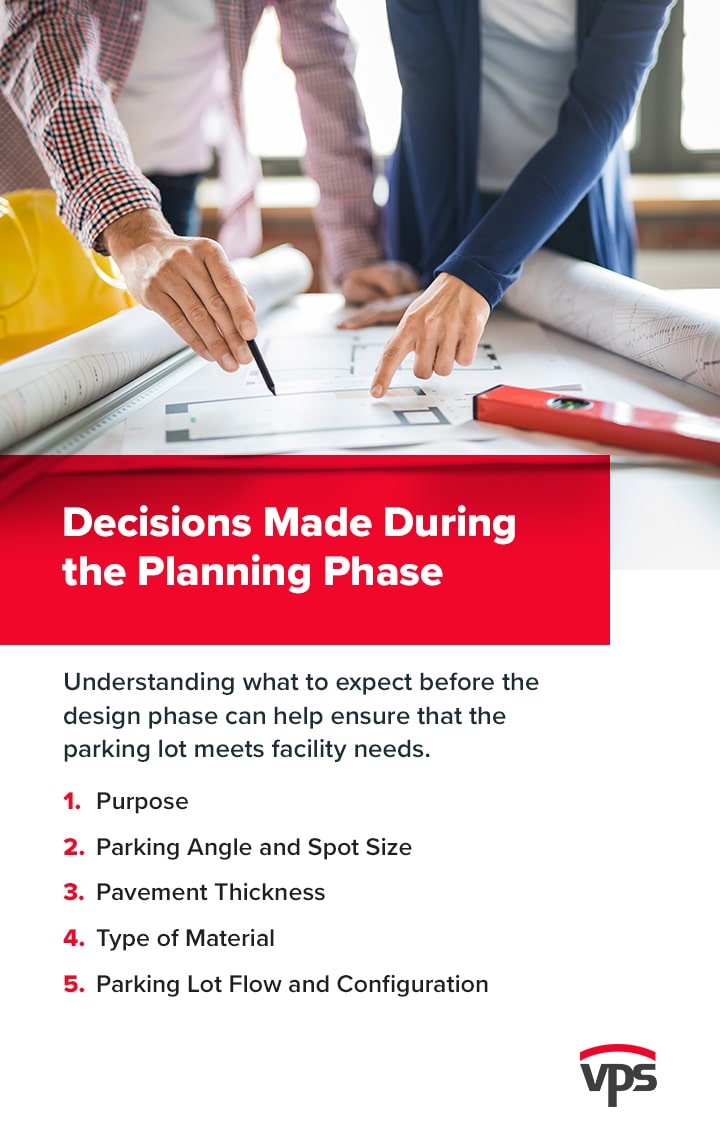What to Expect When Planning a Parking Lot Remodel
10.13.22
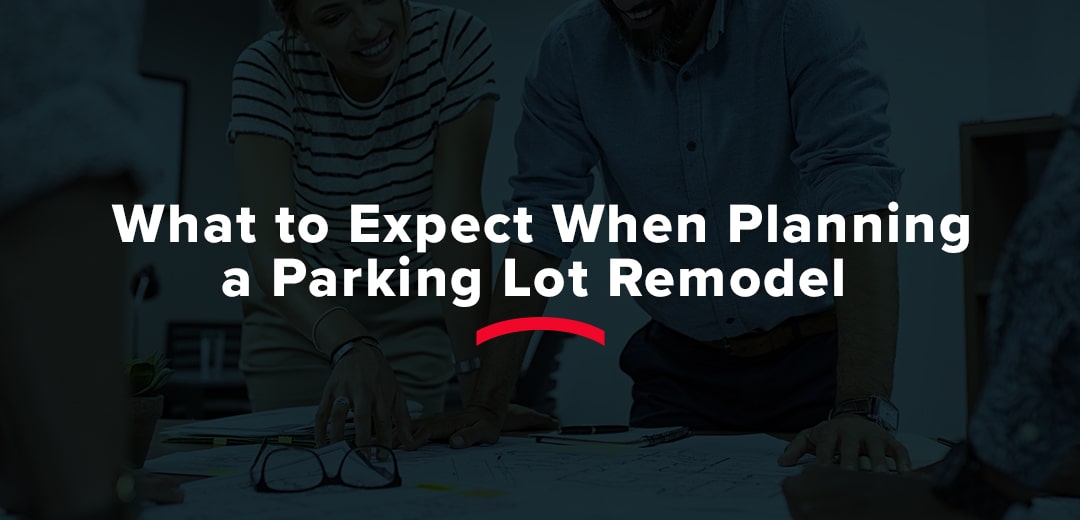
Parking lots are durable and lasting features, but when it's time for a remodel, it's important to understand how to approach and what to expect. Design and planning decisions can impact the quality of the final product and the overall parking experience.
Read the full article or jump to a specific section:
- Decisions Made During the Planning Phase
- Parking Lot Building Considerations
- Design Tips for Remodeling Parking Lots
Decisions Made During the Planning Phase
When approaching parking lot reconstruction steps, planners and designers have many factors to consider. Understanding what to expect before the design phase can help ensure that the parking lot meets facility needs.
1. Purpose
Parking lots can offer different functions and elements depending on what facility they are for. Once designers determine their parking lot's role, they can plan a space that better meets the building's and visitors' needs.
Factors related to a parking lot's purpose include:
- Measurements: While many measurements depend on lot size, the function can also influence many calculations and choices. For example, many grocery stores offer wider spots than other locations to give customers room to park carts and load goods into their cars. Warehouses will require larger spots for tractor-trailers to park and unload goods. Stores with lots of customer turnover and large crowds will have a different configuration than a smaller location with all-day parking.
- Lot condition: Soil quality influences pavement thickness because it helps support the lot's vehicles. The purpose can also determine what material to use. Temporary lots for short-term events can benefit from less stable solutions, while permanent lots require more durable materials.
- Features: While designers might have an empty area to work with, some of that space can go towards features other than parking spaces. One example is a food chain restaurant that needs space to dedicate to a drive-through, or a grocery store that offers curbside services and needs space for these customers. Emergency rooms need areas where ambulances and emergency vehicles can bring patients for immediate care.
- Compliance and standards: Depending on the industry, designers must adhere to different regulations. For example, some states have requirements for hospitals to have 10% of their parking reserved for handicapped individuals. Local authorities and state governments also have standards that organizations must follow when designing parking lots and drainage systems.
- Accessories: Many buildings have functions that extend to the parking lots. Grocery stores need cart racks so customers can load their items and return their carts without needing to go back into the store. Government buildings have restricted access, and barriers can allow only approved officials and visitors with passes and identification past the checkpoints. Like parking lot features, these accessories require space and designers must plan around them.
2. Parking Angle and Spot Size
Parking spot angles can help support the lot's purpose. The angles allow for different visitor types and patterns, and it's important to tailor parking lots to a specific facility. Some angles impact the lane size and vehicle capacity, helping planners optimize their available space.
Designers can choose from three standard parking spot angles:
- 45°: Great for tighter spaces and smaller lots. They also create more narrow aisles, helping planners optimize their space to fit as many slots in one area.
- 60°: Ideal for easy access because they create enough space for visitors to navigate in and out of areas easily. Both this type and 45° spots are ideal for applications with lots of space turnover, like commercial locations. Customers can better move around lots and spaces, creating a more positive parking experience.
- 90°: Better for areas where vehicles will sit for extended periods, like overnight or airport parking. Perpendicular spots make it harder for visitors to pull in and out, so they are better for places with slower turnover and movement.
Depending on the location, designers can also implement parallel parking. These spots optimize curb space and areas where there isn't room for perpendicular parking.
While size can change based on the function, the standard parking spot size is around 9 feet by 19 feet. This system allows designers to give motorists enough space for many car models to park safely. Planners can adjust the size for many reasons — for example, they will need to match spaces to specific proportions when designing loading spots for trucks. Designers may also need to consider wheelchair accessibility when planning their space sizes.
3. Pavement Thickness
Pavement thickness must match the parking lot's needs and requirements. Thicker pavements can better support heavier trucks and load capacities. For grocery stores, warehouses, and shipment facilities, the thick pavement will be necessary to protect the parking lot integrity from frequent heavy trucks. Implementing this step in the remodeling process can ensure planners design a more durable parking lot.
Pavement thickness can also depend on the condition of the subgrade soil, or the ground below the pavement. This material serves as the parking lot's foundation. Weaker soil will result in a parking lot that can support less. To counter this, designers in industrial lot planning can opt to increase the pavement thickness.
4. Type of Material
There are several material options when redesigning a parking lot, and each offers unique benefits and considerations. The material options include:
- Asphalt: Asphalt is prevalent for parking lots because it is durable and easy to install. When facilities use asphalt parking lots, they can open their lot immediately, allowing them and visitors to make the most of the space. Its sleek, black appearance gives it a professional aesthetic that can apply to several facility types. Asphalt does require regular cleaning to eliminate stains and sealing to prevent cracks.
- Concrete: If a facility wants a strong, long-lasting parking lot, they can invest in concrete materials. With concrete parking lots, designers can maintain their final products easier, with only washes needed. If cracks occur, filling them can solve the problem. Companies have more finish options with concrete, allowing them to explore unique designs. The concrete does need time to sit after installation, preventing visitors from entering the lot, and installation costs can be higher for this material type.
- Tar and chip: This material includes a layer of tar spread over a layer of level chips. They require little to no maintenance, making them great for parking lots. While visitors might have to wait after installation, the setting period is short. However, the tar finish is prone to scratches and scrapes, making it less ideal for facilities that want a particular appearance.
- Gravel: Gravel is an excellent option for temporary and permanent parking lots. It has a lower installation cost than most materials, and visitors can begin parking immediately. Gravel does lack durability and stability because it shifts very easily. Anything from tire tracks to rain can move it, requiring frequent maintenance to keep it level and safe.
- Pavers: Pavers are portable materials that designers can place over land to create instant parking. They are great for temporary parking lots, but many use them permanently. Companies sell these in many types so designers can implement the kind that works best for businesses. They require little maintenance, and porous options help optimize drainage while supporting stability.
5. Parking Lot Flow and Configuration
When remodeling a parking lot, many planners redesign the area's layout to use space more efficiently and optimize movement flow. When working with a rectangular lot, placing rows along the longer side helps optimize space. Designers can use double-sided rows to give drivers options on both sides of their cars. Single-row lanes, perpendicular parking, and parallel parking options can make best use of curb spaces and corner areas.
Parking lot flow is also essential to consider during parking lot building procedures. Designers need to create a positive driver experience that prevents confusion and frustration. They can make the space easier to navigate with parallel rows of spots, creating simple paths for motorists to follow. Other best practices include avoiding dead-ends and using plenty of navigational signs and pavement markers.
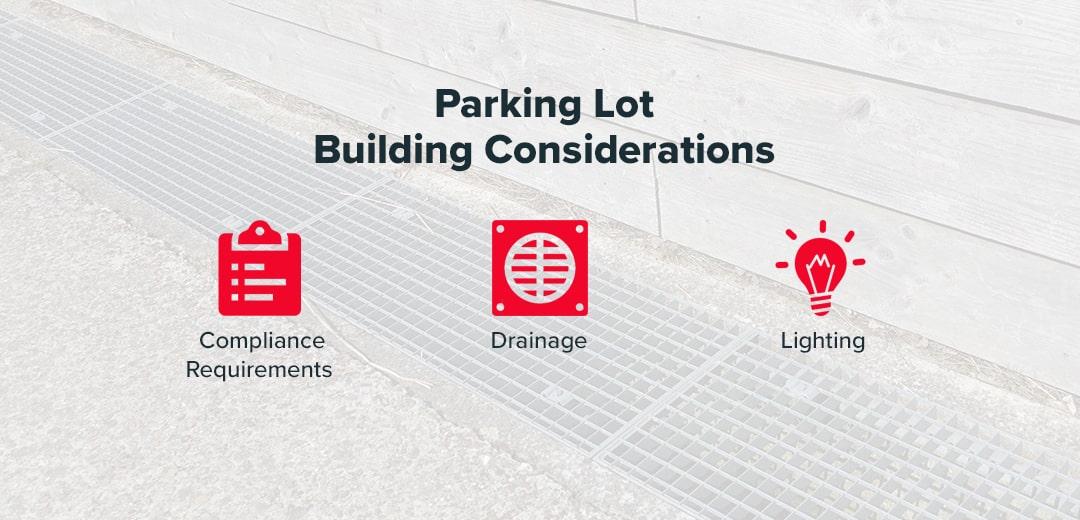
Parking Lot Building Considerations
Many planning factors go beyond client preferences or parking lot function. Planners must follow various regulations and implement design choices to create a durable, accessible parking lot.
Compliance Requirements
Depending on the area and industry, parking lots require careful design considerations for dimensions. From lot sizes, angles, and lane spacing, parking lot reconstruction encompasses many elements to consider. Parking lots with surrounding curbs and elevated storefronts should have access ramps. Breaks in curbs can allow people with mobility needs to navigate parking lots safely.
Builders and designers will need to accommodate accessibility. The Americans with Disabilities Act (ADA) requires all parking lots to have several guidelines for more accessible and compliant parking lots. They outline how many handicapped spaces parking lots must have depending on their capacity. For example, a 150-space lot will have five handicapped spaces to remain compliant, while a 500-space lot needs eight.
Additionally, the ADA specifies that one of six handicapped spaces must be van accessible. These spaces are larger and have a small walkway on the side, allowing room for wheelchair users to exit vehicles safely. These spaces should be marked with signs indicating their use for vans and the walkways should be painted with crosshatched lines. The paint design can help prevent other drivers from using or blocking these spaces so they remain accessible to vans.
Drainage
Improper drainage methods can lead to parking lot damage in the future. Without drains, parking lots can flood, making them inaccessible to visitors. Moisture can seep through the pavement and cause cracks and instability, increasing the risk of potholes and other hazards.
Designers can increase their parking lots' durability and life span by integrating proper drainage methods. The pavement should guide water toward drainage systems. When planning a parking lot, designers can meet drainage standards by sloping their pavement by 2 to 5%. This slope degree helps prevent flooding while ensuring the parking lot is easy for visitors to navigate on foot and in their vehicles.
Lighting
Parking lot lighting helps drivers and pedestrians safely navigate areas, protecting them from accidents and other dangers. When motorists have lighting over parking spaces, they can make sure to park within the lines.
It's important to be strategic with lighting placement. Parking lots need enough lamps and overheads to ensure visibility and safety on the premises, but too much can create a glare on storefronts and surrounding residential areas. Designers can combat this problem by increasing light density around more heavily trafficked areas, like parking lot entrances, pedestrian crosswalks, and surrounding roads.
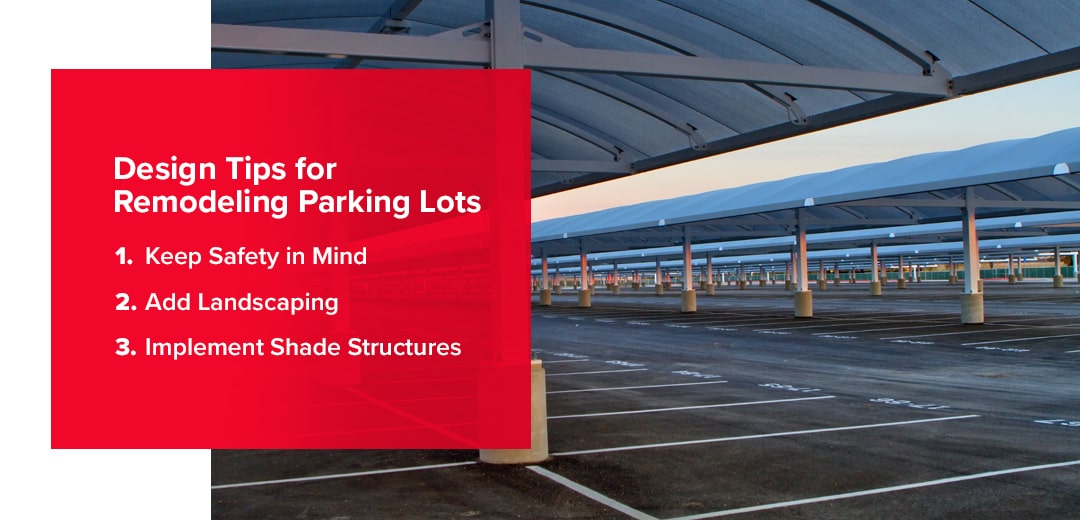
Design Tips for Remodeling Parking Lots
During the design phase, organizations have more freedom to make specific choices that can set their parking lots apart from others.
1. Keep Safety in Mind
Design features can impact the safety measures that drivers and pedestrians take while in parking lots. Signs are a great way to promote safety and can relay several kinds of information to individuals, from parking hours to reserved parking spaces. Designers can place traffic signs throughout lots or surrounding roads to create safer environments, including stop, yield, and no-entry signs.
Pavement paint can relay other messages to visitors. Paint can distinguish handicapped parking spaces from regular ones, preventing cars from getting towed. Delineating pedestrian crossings with pavement stripes can also increase visitor safety. These systems help direct pedestrians safely from parking lots to their destinations and make drivers more aware of others.
2. Add Landscaping
Landscaping can give a parking lot both functional and decorative features. Curbs decorated with shrubs and trees can separate parking lots from busy streets, giving visitors a protective cushion from traffic. Trees interspersed throughout parking lots can bring nature into industrial areas for a more inviting appearance.
Flowerbeds are great for attracting pollinators and boosting the curb appeal of stores and businesses. When it rains, the plants can soak up some of the rainwater, reducing the amount that goes down drains. During heavy rainstorms, these green spaces can help reduce the risk of flooding.
3. Implement Shade Structures
Shade structures are customizable features to consider when revamping a parking lot for their many benefits, including:
- Sun protection: Shade structures block out the sun, protecting people from harmful UV rays. Whether cars sit in the sun for minutes or hours, they can heat up quickly. Shade structures can help keep vehicles cool, creating a more positive experience for visitors when they return to their cars.
- Weather protection: In addition to the sun, shade structures can reduce the impact of other weather phenomena. During hailstorms, shade structures can provide essential cover for individuals and vehicles, increasing safety during the storm. Visitors can rest assured knowing the shade structures can help prevent some of the damage caused by hail.
- Visual appeal: Designers can cater to their client's aesthetic requirements with shade structures. The versatile and diverse styles allow designers to find a shade solution that will match existing structures. Dynamic designs can help increase brand recognition among customers, boosting an organization's branding and reputation.
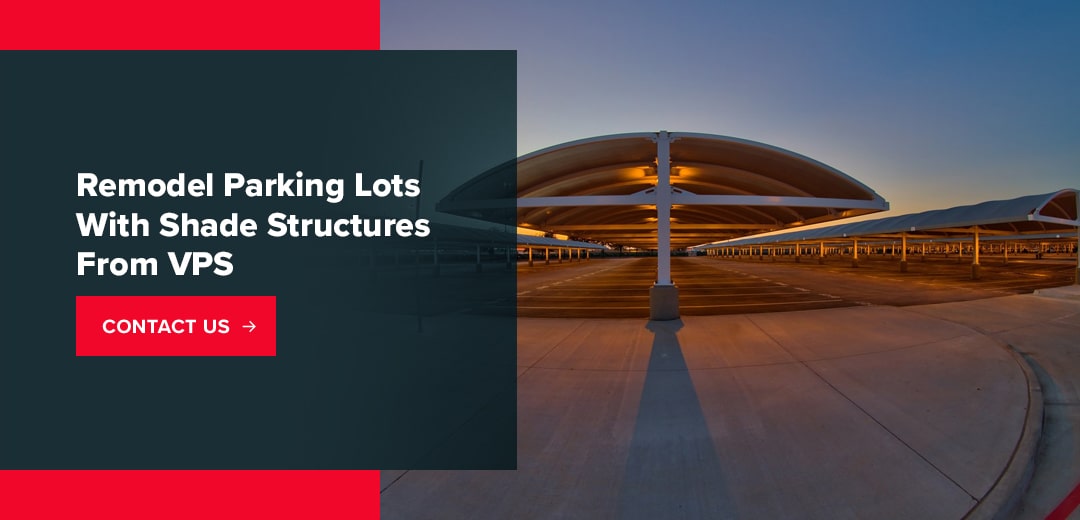
Remodel Parking Lots With Shade Structures From VPS
When reconstructing a parking lot, designers have many factors to consider. When they need to make decisions, they need the right partners. At VPS, we supply car dealerships and commercial companies with the shade structures they need to protect their vehicles and customers in their parking lots. With structures that block 96% of the sun's UV rays and can withstand high winds and hailstorms, VPS shade solutions are durable, long-term investments for facility parking lots.
Contact us today to learn more about VPS shade structures.
